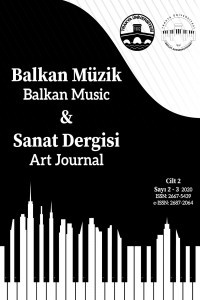MÜZİKAL POSTMODERNİZM BAĞLAMINDA LUCIANO BERIO’NUN SINFONIA (1968-69) ESERİ
II. Dünya Savaşı sonrasında, toplumsal yaşama egemen olan ideolojik belirsizlik, savaş öncesi düşünce sistemlerinin sorgulanmasına neden olmuştur. Modernizmin eleştirisi olarak ortaya çıkan bu düşünce sistemi, postmodern tartışmaları tetikleyerek kültürel alanlarda da etkisini hissettirmiştir. İlk olarak felsefenin tartışma konusu olan postmodernizm, dönemin sanatçılarının avant-gard hareketleri sorguladıkları ve geçmişin birikimini kucakladıkları yeni üretim biçimleri doğurmuştur.
Postmodernizm, felsefe, mimari, edebiyat ve görsel sanatlarda olduğu kadar, müzikte de etkili olmuştur. Dönemin bestecileri geçmişin hazinelerini özgürce kullanabilecekleri, bozup yeniden yapabilecekleri bir ortama kavuşmuşlardır. Sanatın tüm dallarında olduğu gibi alıntılama, kolaj ve pastij yöntemlerini kullanmışlardır. Müzikal postmodernizmin en etkileyici örneklerinden biri Luciano Berio’nun (1925-2003) Sinfonia adlı eseridir. 1969 tarihli eser, yüzyılın önemli dönüm noktalarından biridir. Devasa kolajı ile dönemin ruhunu mükemmele yakın bir şekilde somutlaştırmıştır.
Anahtar Kelimeler:
Postmodernizm, Müzikal Postmodernizm, Luciano Berio, Sinfonia
LUCIANO BERIO'S SINFONIA (1968-69) IN THE CONTEXT OF MUSICAL POSTMODERNISM
After the World War II, the ideological uncertainty that dominated social life caused the pre-war thought systems to be questioned. This system of thought, which emerged as a critique of modernism, triggered postmodern debates and made its impact felt in cultural areas as well. First of all, postmodernism, which is the subject of discussion of philosophy, gave birth to new forms of production in which the artists of the period questioned the avant-garde movements and embraced the accumulation of the past.
Postmodernism has been influential in music, as well as in philosophy, architecture, literature, and the visual arts. The composers of the period gained an environment where they could freely use the treasures of the past, destroy and remake them. As in all branches of art, they used quotation, collage and pastige methods. One of the most impressive examples of musical postmodernism is Luciano Berio's (1952-2003) Sinfonia. The work dated 1969 is one of the important turning points of the century. With its huge collage, it embodied the spirit of the period in a near perfect way.
Keywords:
Postmodernism, Musical Postmodernism, Luciano Berio, Sinfonia,
___
- BERIO, Luciano, Two Interviews, Marion Boyars Publishers, 1. Basım, A.B.D. 1985
- CHEVASSUS, Beatrice Ramaut, Müzikte Postmodernlik, 1. Basım, Pan Yayıncılık, İstanbul 2004
- COPE, David H., New Directions in Music, 4. Basım, Wm. C. Brown Publishers, A.B.D 1984
- DEMİREL, Evrim, “Müzikte Postmodernizm”, E-Journal of New World Sciences Academy, NWSA-Fine Arts, 2013.8.4.D0141, İstanbul 2013
- DIXON, Gavin Thomas, “Polystylism As Dialogue: A Bakhtinian Interpretation Of Schnittke’s Symphonies 3, 4, And His Concerto Grosso No.4/Symphony No.5.”, (Doktora Tezi, London: Goldsmiths College), 2007
- HEAP, Matthew, “Keep Going: Narrative Continuity In Luciano Berio’s Sinfonia And Dillinger: An American Oratorio”, (Doktora Tezi, University of Pittsburgh, 2012)
- KRAMER, Jonathan D., “The Nature and Origins of Musical Postmodernism”, Postmodern Music Postmodern Thought, 1. Basım, Routledge Publish, A.B.D. 2002
- LYNTON, Norbert, Modern Sanatın Öyküsü, 1. Baskı, Remzi Kitabevi, İstanbul 2015
- OSMOND-SMITH, David, “Berio's Sequenzas: essays on performance, composition and analysis”, Introduction IN Halfyard, Aldershot, England; Burlington, VT: Ashgate, 2007
- OSMOND-SMITH, David, Playing on Words: A Guide to Luciano Berio's Sinfonia, London Royal Musical Association, England 1985
- TAYLOR, Timothy D., “Music and Musical Practices in Postmodernity”, Postmodern Music Postmodern Thought, 1. Basım, Routledge Publish, A.B.D. 2002
- VIEIRA, Carlos Eduardo da Silva, “Luciano Berio: Sinfonia (1968-9)”, Term paper submitted as partial fulfillment of the requirements for the course on Proseminar Music 20th Century MUS 558, University of Alabama Fall 2012
- ISSN: 2667-5439
- Yayın Aralığı: Yılda 2 Sayı
- Başlangıç: 2019
- Yayıncı: Trakya Üniversitesi
Sayıdaki Diğer Makaleler
PİYANO EŞLİKLİ ESER SÖYLEMENİN DİKKATE OLAN ETKİSİ
MÜZİKAL POSTMODERNİZM BAĞLAMINDA LUCIANO BERIO’NUN SINFONIA (1968-69) ESERİ
Özden Gülsün KESKİN, Ahmet Hamdi ZAFER
BEETHOVEN’İN 3. SENFONİSİ’NDEKİ OBUA SOLOLARININ TEKNİK VE MÜZİKAL AÇIDAN İNCELENMESİ
MÜZİK ALANINDA ÖZEL YETENEKLİ ÖĞRENCİLERİN BİLSEM EĞİTİM SÜRECİ
KEMAN LİTERATÜRÜNDE DOĞU MOTİFLERİ
PİYANODA BAŞPARMAĞI KUVVETLENDİRMEK İÇİN ETKİLİ ÇALIŞMA YÖNTEMLERİ
RESİM SANATI VE MÜZİKTE EŞZAMANLILIK KAVRAMI: CEZANNE, PICASSO VE STRAVINSKY
